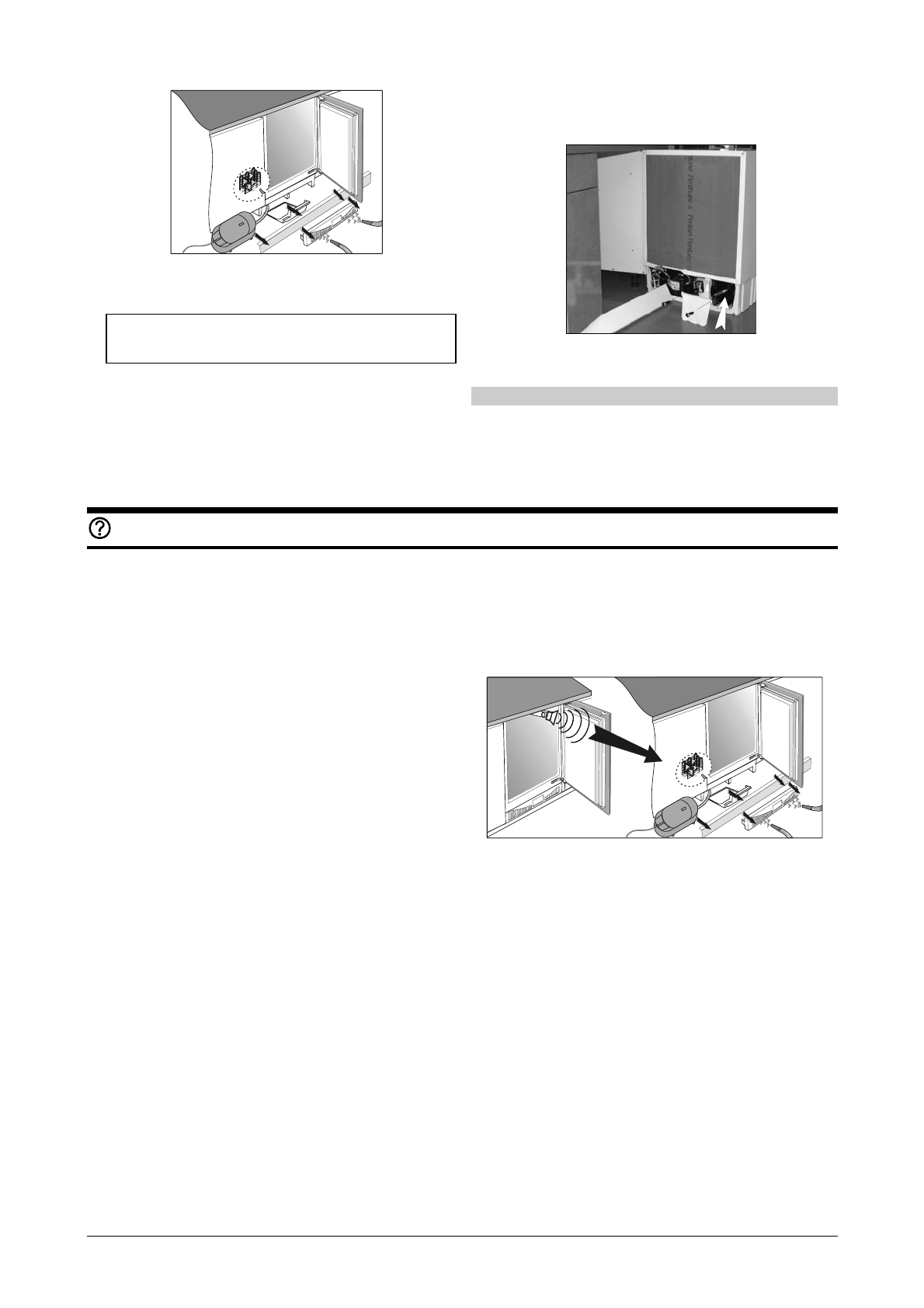Холодильник Smeg FL144P - инструкция пользователя по применению, эксплуатации и установке на русском языке. Мы надеемся, она поможет вам решить возникшие у вас вопросы при эксплуатации техники.
Если остались вопросы, задайте их в комментариях после инструкции.
"Загружаем инструкцию", означает, что нужно подождать пока файл загрузится и можно будет его читать онлайн. Некоторые инструкции очень большие и время их появления зависит от вашей скорости интернета.

Instructions for Use
12
After cleaning, connect the appliance to power supply and reload it.
Periodical cleaning of the condenser
In order to optimize the operation of the appliance and save
energy, it is recommended to clean periodically the dust from
the condenser at the back of the appliance.
Disconnect the appliance from the mains prior the
commencement of cleaning!
x
Empty the contents of the appliance.
x
Remove the supporting panel from the bottom of the kitchen
cabinet.
x
Remove the screws fixing the appliance to the kitchen worktop.
x
Pull the appliance out and expose the condenser at the back of the
appliance.
x
Unscrew the screws from the condenser bonnet and remove the
bonnet.
x
Clean the dust and dirt from the condenser.
After cleaning return the appliance to its place, plug in the
mains power cord and fill with food.
Switch Off the Appliance When Not In Use
If you do not intend to use the appliance for a longer period, set
the thermostat knob to the
STOP (0)
position, disconnect the
power supply, take out the foods and defrost and clean the
appliance. Leave the door slightly open.
Trouble-Shooting Guide
During the service, you can come across some troubles that in
most cases result from improper handling of the appliance and
can easy be eliminated.
The Appliance Fails to Operate After Connecting to the
Mains Supply
x
Check the supply in the outlet socket and make sure the
appliance is switched on (thermostat knob in operating
position).
Continuous Operation of the Cooling System
x
The door was frequently opened or it was left opened for too
long.
x
The door is not properly closed (the door may sag, the
gasket may be polluted or damaged).
x
Perhaps you have overloaded the appliance with fresh
foods.
x
Insufficient cooling of compressor and condenser.
Check the air circulation through the bottom rail openings
and if necessary clean or vacuum the dust from the
condenser. See Section
Cleaning and Maintenance.
Ice Formation on the Inner Rear Wall
Until the water is drained through the hole in the rear and into
the receptacle at the bottom of the appliance, normal
automatic defrosting of the appliance is guaranteed.
In case the ice formation on the inner back wall is increased (3-
5 mm), ice should be manually defrosted.
Set the thermostat knob to
STOP (0)
position and leave the
door open. Never use electric devices for defrosting and do not
scrape the ice or frost layer with sharp objects.
After completed defrosting, turn the knob to desired position
and close the refrigerator door.
The cause of increased ice formation may be one of the
following:
the door does not seal well (clean the gasket if it is
contaminated, or replace it if it is damaged);
the door was frequently opened or it was left opened for
too long;
the food stored in the refrigerator was warm;
the food or dish is touching the inner back wall.
Sound alarm
The excessive dust upon the condenser is signaled by the
sound alarm, heard at each opening of the appliance door –
until the default is removed.
Check the air circulation through the bottom rail openings and
if necessary clean or vacuum the dust from the condenser.
See Section
Cleaning and Maintenance.
Water drains into the bottom compartment of the
appliance
Water leaks from the refrigerator if the drain hole is clogged, or
if the water drips past the collection gutter.
x
Clean the clogged outlet, for example with a plastic straw.
x
Manually defrost the increased ice layer. See "Ice Formation
onthe Inner Rear Wall".
Noise
Cooling in refrigerating-freezing appliances is enabled by the
cooling system with compressor, which produces noise. How
noisy the appliance is depends on where it is placed, how it is
used and how old the appliance is.
x
During the operation
of the compressor the noise of liquid
is heard and when the compressor is not operating, the
refrigerant flow is heard. This is a normal condition and it
has no influence whatsoever on the lifetime of the appliance.
x
After starting the appliance
, the operation of the
compressor and the refrigerant flow may be louder, which
does not mean that something is wrong with the appliance
and it has no influence on the lifetime of the appliance.
Gradually the noise is reduced.
x
Sometimes
unusual and stronger noise
is heard, which is
rather unusual for the appliance. This noise is often a
consequence of inadequate placing.
Характеристики
Остались вопросы?Не нашли свой ответ в руководстве или возникли другие проблемы? Задайте свой вопрос в форме ниже с подробным описанием вашей ситуации, чтобы другие люди и специалисты смогли дать на него ответ. Если вы знаете как решить проблему другого человека, пожалуйста, подскажите ему :)































